Featured Artists
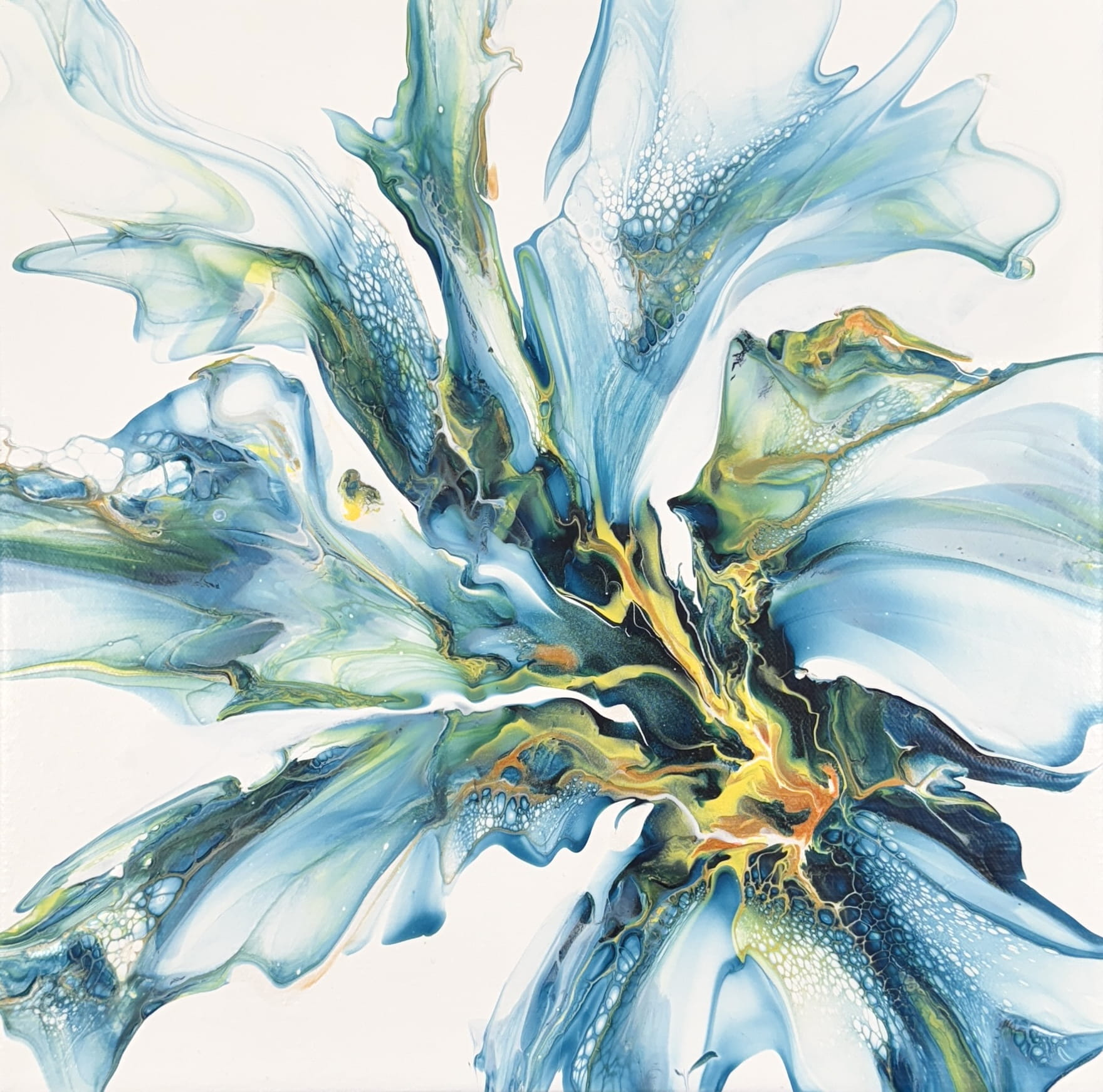
2025-26 featured artist: Rachel Coleman
Abstract Floral
Medium: Acrylic Fluid Painting
Rachel Coleman is a fluid artist living in Chester County, PA with her husband and their dog. Originally from Allentown Pa, Rachel grew up in her mom's ceramic shop cleaning greenware and glazing ceramics. She dabbled in a few of mom's painting classes, but after becoming a rebellious teenager, never looked back at painting ceramics again! Growing up, Rachel played the violin, danced, sang, and later became a hairstylist, but never considered herself a real artist.
In November 2015, Rachel lost her mom to illness and twenty days later lost her father to suicide. This left her in shock, and being an only child, it took a few years to pick up the pieces with the help of her significant other, Tom. After things settled down, she realized it was time to take care of her mental health, so she found a therapist that suggested practicing using the right side of the brain by doing something creative. She figured she'd try painting again and see if some of mom's teachings were still in there somewhere. She went to a hobby store and bought wooden nutcrackers for her and her husband to paint and while painting, she lost all sense of time, anxiety, and stress. Getting a much needed although temporary reprieve from her trauma. So, the next day, right back to the hobby store for more painting projects! After a while, Rachel found fluid art. The way the colors moved across the canvas and created organic shapes was intriguing to her. Rachel tried a few different mediums, but kept coming back to fluid art. She was hooked! "I am a control freak at times, and this medium has really helped me let go. I never have complete control. I can pick my colors and the technique that I want to use, but ultimately the paint is going to do what it wants. After a piece is dry, I will go in and play up what stands out to me."
Over the last four years, the therapy of practicing fluid art has turned into a full-time job. Knowing she either had to dial back making and selling art or jump in full time, she decided to leave her job of ten years in March of 2023 and go for it! Doing that has opened the door to many more opportunities. Rachel has started a local artist support group that meets twice a month for other artists to network, get advice from each other, and connect. Rachel says, "I never felt like I quite fit in anywhere growing up, but art has led me to my people. My local art community inspires me and lifts me up. I'm so grateful!"
Rachel has a rare degenerative eye disease called Retinitis Pigmentosa. Symptoms began as a child for her and have increased as she has gotten older. Some of the symptoms are decreased vision at night, trouble seeing in low light, and loss of some peripheral vision. Because of this Rachel is no longer able to drive at night or if it's overcast. Fortunately, her husband and artist friends help her out when she needs it. Rachel says "Being an artist living with this eye disease can be stressful, so I try to remember to be grateful for every day that I have my sight. Things could always be worse." There is no cure at this time for the disease, but Rachel stays on top of the progression with the help of her specialist closely monitoring it.
Rachel's biggest inspirations are color, biology, and the elements of nature, which are all reflected in her work. "When I get a color in my head, I have to get it out on canvas a couple times until it's out of my system. It's like an obsession that needs to be released."
Rachel says "Making art has helped me come out of the dark. It is still hard at times, but being able to create helps immensely. I am beyond grateful for finding my passion and being able to make it full time. The biggest gift is the people I meet and being able to share my work with others. Today I can say with confidence that I am an artist!
I have a lot of people tell me that they don't have an artistic bone in their body, but I always say that you never know if you don't try. That's why I started teaching workshops. People are amazed at what they can do!"
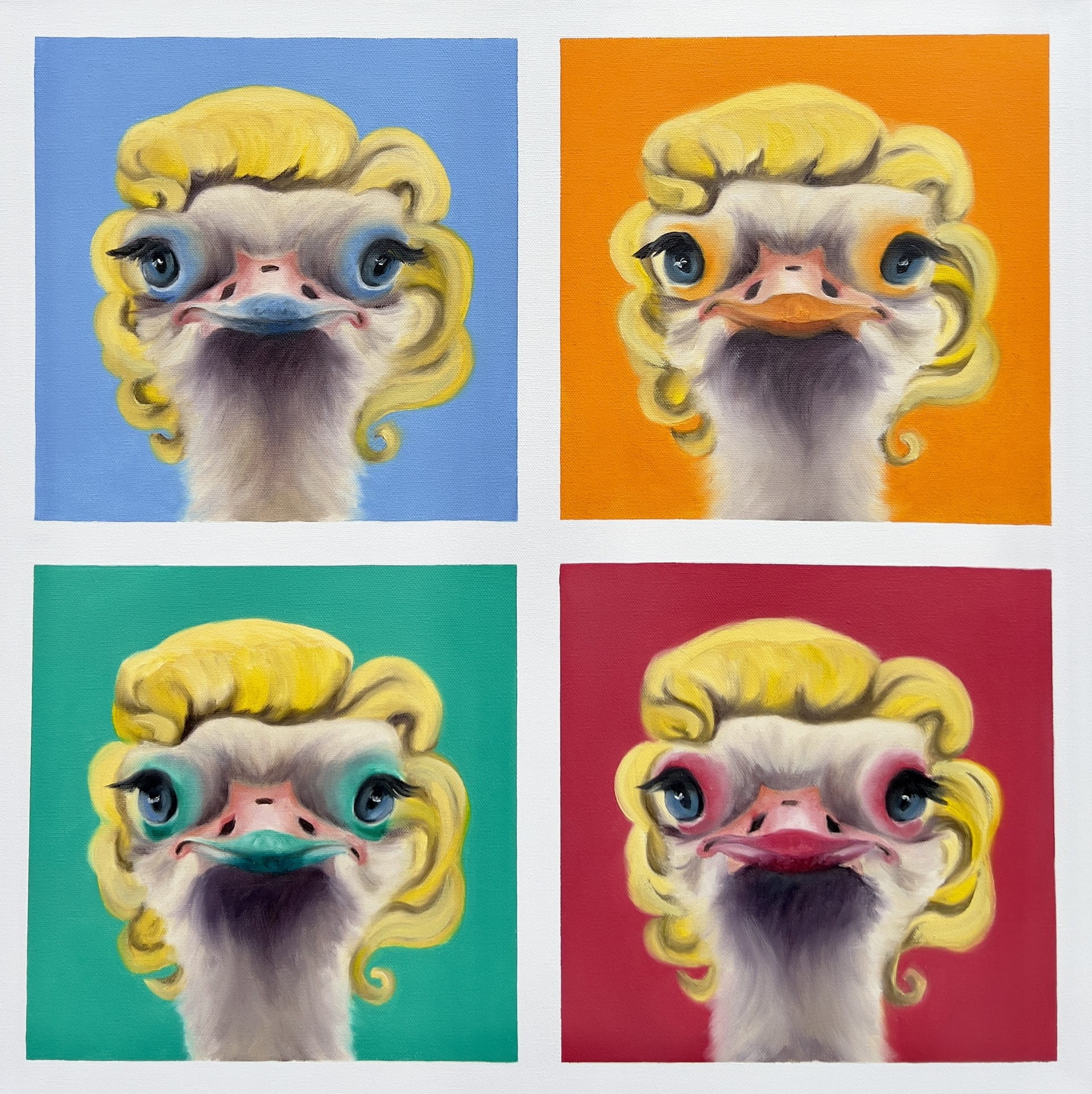
2024-25 featured artist: Rebecca Scheuer
Norma Jeane Ostrich Queens
Medium: Oil Painting
Rebecca Scheuer is a retired high school counselor and artist living in Lancaster County, PA with her husband, two dogs and two cats. She began her oil painting journey in 2015 after a serious car accident. Rebecca and her husband, John, were hit head on by a texting teenager going 80 miles per hour. The accident left her with a concussion, hemorrhage behind her right eye, and months spent in a fog with severe double vision. Her visual therapist suggested painting as an exercise in hand/eye coordination. Having never dabbled in anything more than a few craft projects, Rebecca immediately took to painting and devoted herself to her practice. She began taking painting lessons with Bruce Becker at The Warehouse Studios in Reading, PA who helped her hone her style and technique.
Despite her challenges, Rebecca has maintained a cheerful, positive outlook on life and her sense of humor is often reflected in her colorful, whimsical paintings. She enjoys painting animals and cocktails, two of her favorite things. Rebecca says, "Painting things that make me smile has given me the opportunity to express myself and share my love of bright colors, nature, and the simple beauty in our everyday surroundings. It took an unfortunate event to jumpstart this journey, but now I'm hooked."
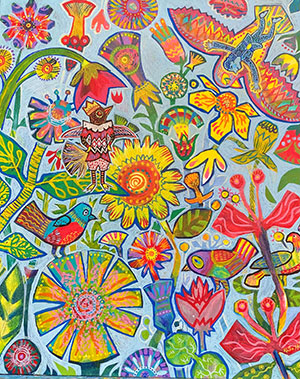
2023–24 featured artist: Kelly McQuain
Meeting the Bird King
Medium: Acrylic Painting
Kelly McQuain’s jubilant paintings feature people and animals in symbolic arrangements that hint at mysteries of the imagination. His work in acrylics, mixed media, and watercolor start with abstract color washes and random patterns over which he teases out shapes in a manner akin to a daydreaming child imagining animals in the clouds. Recent works are inspired by his ADHD, which he describes as akin to trying to focus on three radio broadcasts at once. McQuain harnesses his neurodivergence as a source of inspiration, channeling overlapping stimuli into innovative ideas as unusual connectomes wire together inside his head. He often paints “in reverse”: the abstract initial layers of his paintings emerge as the foreground as he pushes the negative space around his subjects toward the back, teasing new imagery and order from the chaos of his initial start. He views this technique as a "palimpsest" approach (palimpsests are materials on which original writing has been effaced to make room for later writing, but of which traces of the original layers remain). This approach stems in large part from McQuain's love of literature and work as an English professor and poet (his 2023 collection, Scrape the Velvet from Your Antlers, recently won Texas Review Press's Southern Breakthrough Award). He also draws on the folk art of his native West Virginia as well as his outsider status as a gay man living with a genetic demyelination disease (HNPP). This neuropathy affects his hands, sometimes causing his paint brush to fly from his fingers and mar his canvas. "Happy accidents" he calls such marks, often incorporating them into his patterns and shapes. Always open to randomness and discovery, he has also been known to turn leaves, acorn tops, and flowers into spur-of-the-moment painting tools as he works each summer in his backyard in Philadelphia's Italian Market. McQuain has exhibited work at the Barnes Foundation, the National Liberty Museum, Philadelphia City Hall and the William Way LGBTQ Center, and he thanks Art Ability and Bryn Mawr Rehab Hospital for this wonderful opportunity to share his work with you.
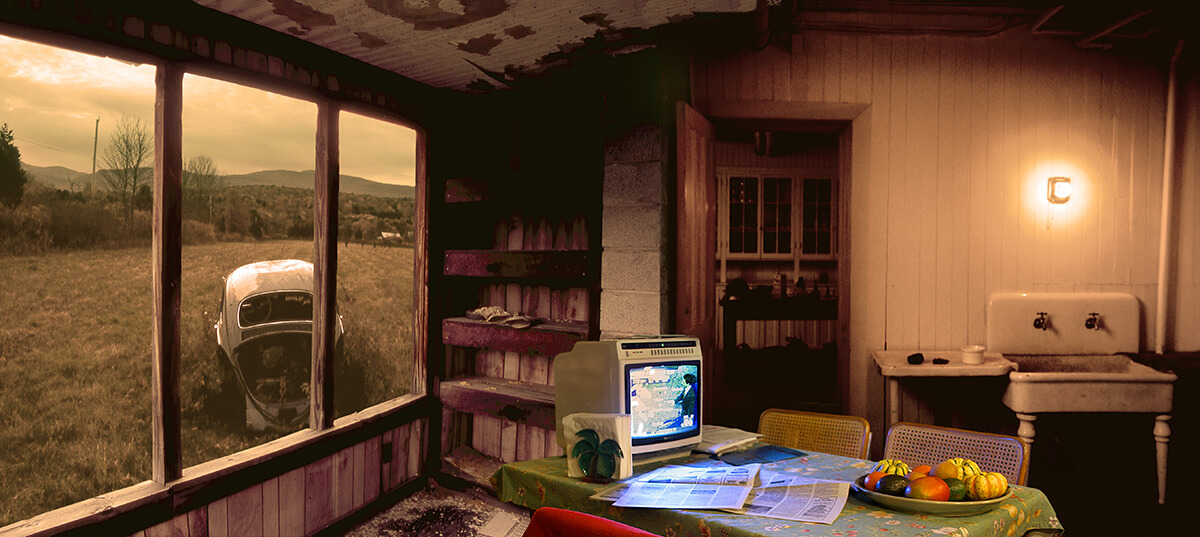
2022–23 featured artist: Allen Bryan
Weather Report
Medium: Photography
After setting up an easel at the age of four to paint next to his aunt, Allen Bryan has been a visual artist for his entire life. Allen's career includes being a teacher of art and filmmaking in a public school system, a partner of a fine craft gallery, a jewelry designer/goldsmith and for the last 40 years, a photographer. For the past decade he has been making connections between his early pictures of quickly taken street photographs or ironic juxtapositions and the slower, contemplative landscape work that followed when he learned that his eyesight was slowly diminishing. Having less than ten degrees of visual field, he sees things in discrete sections, with no periphery on the sides or up and down. Things appear suddenly or not at all. His color perception is reduced as well. He says, "I became a better photographer after I learned that I was losing my eyesight."
In his work, the viewer is invited into unsettling places and precarious living situations to discover something of the lives of the phantom occupants. These are worlds that are not as real as they appear at first glance. They are figments constructed from film and digital images spanning many years. Planes and perspective often conflict and contradict. Exteriors intrude into interiors through windows and doors left carelessly ajar. People are mere ghostly blurs or fragmented presences at the picture's edge. Wandering through these unstable environments, hoping to uncover their stories, time becomes an active element. His pictures reexamine and reorganize his photographic life through photo assemblages that question a comfortable reality. These narratives from his continuing series, Comforts of Home: Figments of Domestic Tranquility, ironically grew into a format much wider than Bryan can see in a single glance.
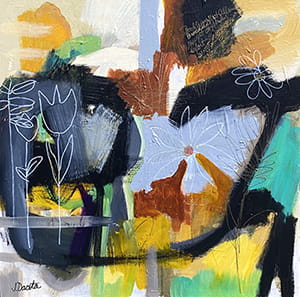
2021–22 featured artist: Jen Dacota
Back to School
Medium: Mixed media
When Jen Dacota saw her MRI, and the "big black hole" where part of her brain used to be, her jaw dropped! What had happened to her was truly horrific. Dacota had just suffered a bilateral hemorrhagic occipital stroke, and was very lucky to have survived.
While home recovering, and with damaged, reduced vision, and comprehension difficulties, she knew right away that life would be different, and she could not continue to pursue her rewarding career as a Physical Therapy Assistant in a hospital. Having worked in Physical Therapy, a most useful idea sparked – why not try to paint as a form of therapy? She had always been artistically inclined, but had never tried painting.
Starting over as a visual artist with a disability, Dacota began with what she knew. Her first artworks were attempts at copying realistic images she found. Active in her new creative outlet, she ultimately found herself dissatisfied with the outcome, and felt she was failing. Dacota finally realized that her kind of brain damage was hindering the process.
All of Dacota's emotions that were built up, from the stroke and her inability to connect with her art, were clamoring to escape. She put away the books and magazines filled with images, turned on some lively music and simply began to paint. All her frustrations and disappointments melted away! Painting has put her in touch with her true self and feelings. Through painting, Dacota can express herself without using words. She finds "the gift of creativity" to be a valuable gift received from her stroke.
Dacota knows that creating a painting is far more involved than dancing around and flinging paint. She says a good painter has a cohesive understanding of color theory and composition, and these are elements of design that she learned a lifetime ago, having received a B.A. in Arts Education.
Dacota challenges herself with every painting she creates. She knows a painting is a success when she feels every problem before her is solved, and all the elements of design work together beautifully.
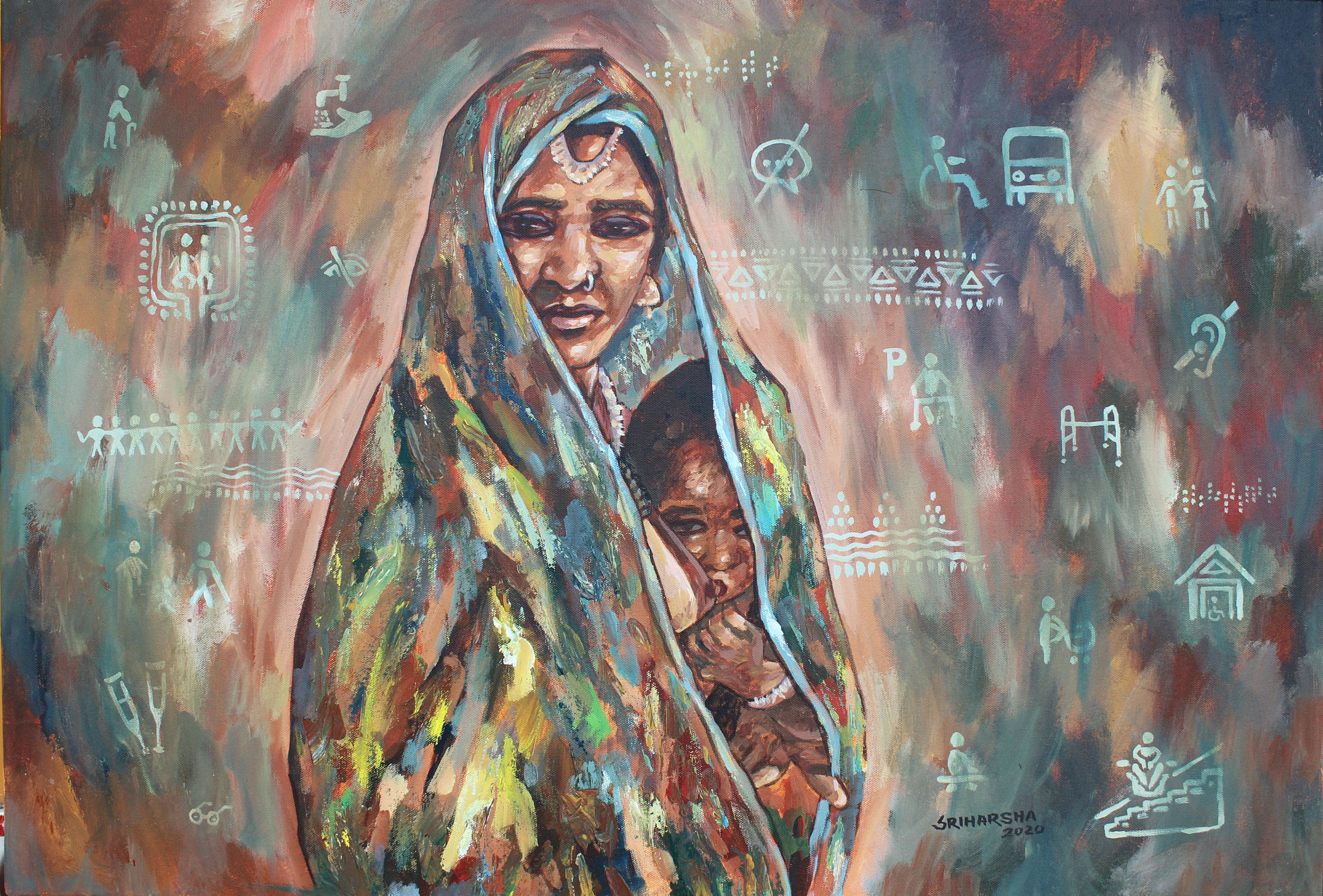
2020–21 featured artist: Sriharsha Sulka
Baby Deaf
Medium: Acrylic on canvas
Indian artist Sriharsha Sukla was born deaf and nonverbal, and has been painting since early childhood. He is prolific, successful, and participates in many exhibitions for artists with disabilities. Sriharsha was trained in Patachitra, a traditional, clothbased scroll painting, based in the eastern Indian states of Odisha and West Bengal. This artform is known for its intricate details as well as mythological narratives and folktale themes. Sriharsha has a BFA from the Uktal University in India, and has learned to visually express himself in many mediums, including oil painting, watercolor, photography, and also computer animation used in several Bollywood films. A versatile artist, Sriharsha specializes in landscape and portrait art using a cut paper collage technique, regularly on view at Bryn Mawr Rehab. His artwork was awarded 1st place in Art Ability's Works on Paper category in 2007. Sriharsha also teaches collage workshops to youth and adults. Sriharsha has been encouraged by his parents, especially his mother, to be a professional artist. In spite of their disabilities, Sriharsha and his brother Siddhartha, also a deaf Art Ability artist, feel abled in every respect. They say that they never feel inferior to others because they are "differently abled." In recent years, the use of social media and computer-based communication has given Sriharsha new ways to communicate with the deaf community all around the world. In 2017, we had the pleasure to meet Sriharsha at Bryn Mawr Rehab. He attended the Preview Reception and visited the hospital for several days that week. Because he uses American Sign Language, many of our guests were fortunate enough to communicate with him with the assistance of a translator. A frequent participant in Art Ability, Sriharsha's artworks have developed a strong following. He feels fortunate to have an opportunity like Art Ability that pushes him to be a successful professional, alongside other career artists.
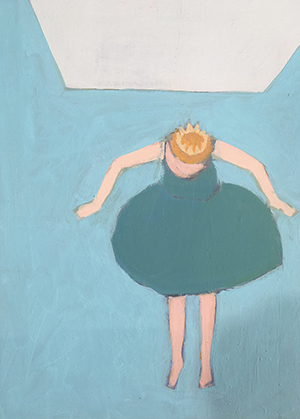
2019–20 featured artist: Carol Spiker
Up, Up and Away
Medium: Oil on paper
Carol Spiker, a former patient at Bryn Mawr Rehab Hospital, has always had a passion for graphic arts. As a busy mom who raised two boys, Carol worked for an ad agency, did a great deal of volunteer work, ran a couple of marathons, and started a lacrosse program that ran for 26 seasons. She then returned to school in the late eighties to study painting, as she wanted to begin creating art that was inside-out versus outside-in. This journey continues today after a few big twists and turns along the way.
In 1998, Carol was thrown into a creek when her car was hit on I-95. She realized immediately that she was paralyzed, and her only words were: "thank God I have my hands." Yes, being paralyzed makes painting more difficult, and she can no longer tackle that 8' x 10' canvas. But, she can still paint. She is one of the lucky ones, and art has become a driving force in her life, a focus that has sharpened even more after her accident.
Painting is her passion—no matter how often she has explored other directions, the figure continues to pull her back to a brush and a canvas. Carol has found that color choices are an important part of her creative process. Her decisions involving colors have evolved over time and reveal evidence of her feelings, while at the same time grow into beautiful passages that empower the picture's surface. Carol says, "I would have loved to hang out with Richard Diebenkorn and the Bay Area Figurative painters in the 50's or Milton Avery in NYC in the 40's!"
Making art exposes oneself, and for Carol, it can be scary. Over time, she has learned that it takes courage to put your creations out there to be seen by the world and for others to judge. Somehow, this understanding—that she must be brave—has helped her through her twenty-year journey as a paraplegic.
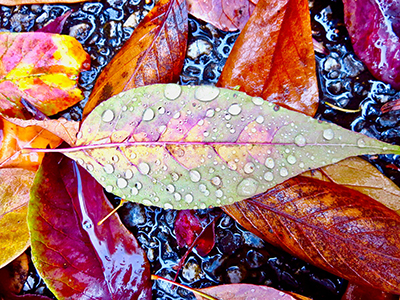
2018–19 featured artist: Maureen Collins
Autumn Rain
Medium: Photography
My art weaves through photography, fabric design, porcelain and silver jewelry, collage, and painting. Inspiration is everywhere: everyday images, sounds, a well turned phrase, colors, textures, the tension of contrast. Re-interpreting each allows me to make them uniquely my own. Creativity is a core part of my soul's expression. A life changing illness, Guillain-Barre Syndrome, years ago left me hospitalized and paralyzed for seven months, with many years of physical therapy in the recovery process. It challenged me to find new modalities of expression, as I learned to move and walk again. Deficits on my left side, in my hands and feet made me explore different ways to express my creative core. Being able to work in the exquisite earth of porcelain again became PT for my hands, and healing for my soul. My work in photography, with printing on metal, has morphed into printing on fabric. The symbolism of moving from paralysis (metal) to fluidity (fabric) is represented here, with the same image being replicated on each substrate. The healing process is the link between the two.
All of the challenges, sensory deficits, pent up feelings of being immobilized for so long gifted me with an unfailing sense of gratitude for the abilities that I recovered. It also infused me with exquisite qualities of hope, to which I anchored my next anticipated movement, my next achieved step, my next desired adventure. Hope was the catalyst that I enlisted to help me move forward, a synergistic partner with creativity, an incentive that propelled me through each day and night. I am grateful for art and creativity in the process of recovery, for the ability to share the beauty and uniqueness in the gift of each day. My mantra now is "Do what you CAN'T!" It inspires me to believe that I CAN do things that I once thought I couldn't.
It gives me HOPE.
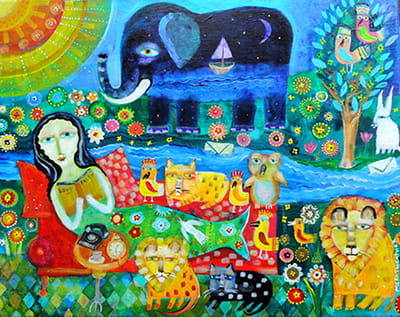
2017–18 featured artist: Allison Merriweather
Faith & Love
Medium: Acrylic on canvas
Allison Merriweather has been selected as the featured artist for Bryn Mawr Rehab Hospital's 2017–18 annual Art Ability Exhibit showcase, which begins on Sunday, November 5. The Houston-based painter, who lives with dyslexia and dyscalculia, says art helps her to enjoy a short-lived escape from reality.
Merriweather explains her foray into art and how it helps her cope with her disability.